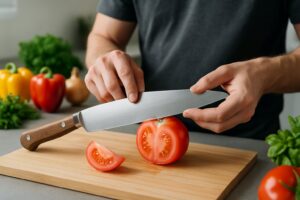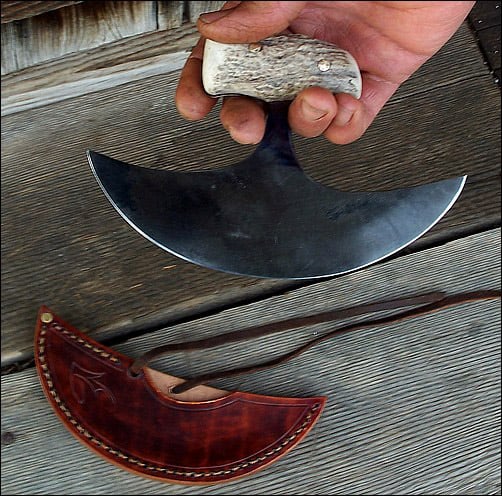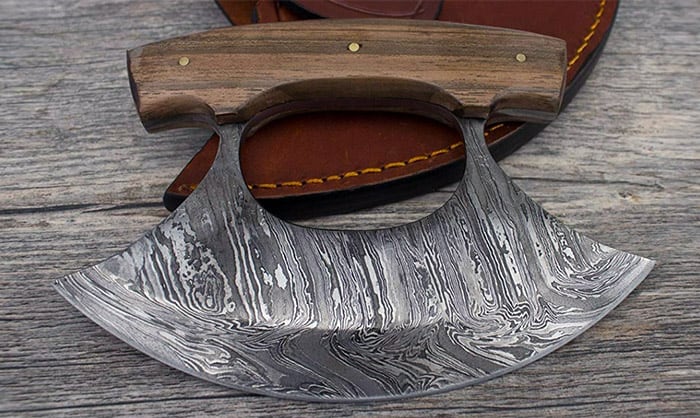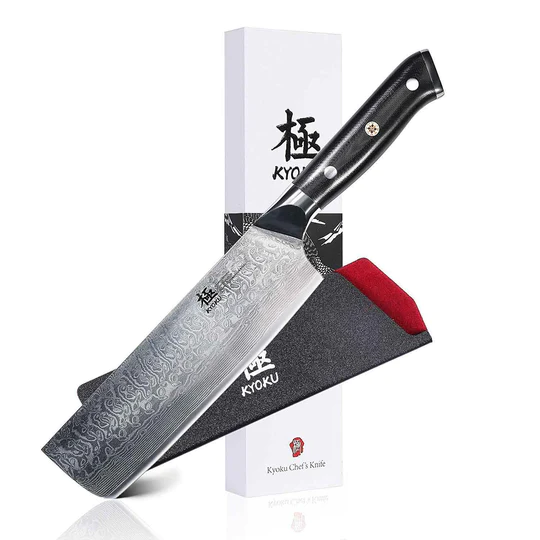


The Ulu knife has a curved blade that is handy for chopping, slicing, and dicing all sorts of foods. Ulu knives can tackle everything from mincing herbs to skinning fish. It’s a quirky, practical tool that’s earned its place in the kitchen.
Modern Ulus come in all sorts of styles and materials. Some feature stainless steel blades, others stick with classic carbon steel. When you are choosing an Ulu, pay attention to the blade material, knife size, and how the handle fits your grip. A solid Ulu should feel balanced and sturdy.
The Ulu knife was first used by northern indigenous tribes including the Inuit, Yupik, and Aleut. Traditional Ulus feature a handle made of caribou antler, musk ox horn, walrus ivory, or other animal bone. Caribou antler and hardwood are still used today for modern Ulu knives.
The blade was usually made of slate, iron, or copper, though today it is made of steel. Modern commercial Ulu knives can have durable plastic or Pakkawood handles and often come with a cutting board or cutting bowl.

The curve of the blade provides a rocking motion, which makes it a great choice for chopping and slicing in one motion. The positioning of the blade places all the hand’s weight on the blade, providing extra pressure for cutting strong objects like bone. This feature also allows you to cut food quickly with one hand.
The Ulu knife comes in several sizes and styles. The smallest size has a two-inch blade and is used to cut sinew or to cut out patterns from animal skins. The most commonly found size is the six-inch blade, which is used for most purposes. The Ulu can also be found with blades as large as 12 inches.
There are four styles of the Ulu knife, each named for their original region:

When we’re shopping for an Alaskan Ulu knife, it’s all about the right features. The “best” knife really depends on how you plan to use it, so here’s what we look for.
| Feature | What to Look For |
|---|---|
| Blade Material | Stainless or carbon steel |
| Handle Material | Wood or plastic |
| Size | Medium for kitchen; large for meat |
| Maintenance | Easy to sharpen and clean |
Blade Material:
Aim for stainless or carbon steel. Stainless steel resists rust and cleans up easily, while carbon steel keeps a sharp edge longer but needs a bit more care.
Handle Comfort:
A good grip matters for both safety and control. Try holding the handle—does it feel right in your hand? Wood’s got a natural vibe, but plastic is usually easier to clean.
Blade Size and Shape:
Ulu knives come in different sizes. For most kitchen stuff, a medium blade works great. If you’re tackling big cuts of meat, go for something wider. Smaller blades are nice for detail work.
We’ve rounded up our favorite Ulu knives. These picks bring together quality, user-friendliness, and performance for all sorts of kitchen tasks.

This one’s a smart pick for anyone wanting an easy-to-handle knife that really shines when you’re dicing or chopping—especially if your hands aren’t the strongest.
Pros
Cons
We tried the Alaskan Ulu Knife in our kitchen and honestly, chopping different foods felt both fun and practical. That curved stainless blade made cutting simple, even one-handed. It was especially handy for salads, nuts, and slicing meats.
Compared to regular knives, this Ulu gave us more control and required less effort. The big wooden handle is easy to grab, which is great if your grip isn’t what it used to be. The rocking motion took a little getting used to—maybe a couple tries—but after that, it felt natural.
The blade stays sharp for ages and is easy to sharpen when needed. The walnut stand is a nice bonus, keeping things safe when you’re not using it. Just don’t toss it in the dishwasher—hand wash only, or you’ll regret it. This knife’s found a permanent spot in our daily cooking lineup.

This knife’s a solid option if you want a reliable, good-looking Ulu for the kitchen or the outdoors.
Pros
Cons
The first thing we noticed was the weight and balance. It’s easy to control, whether we’re mincing herbs or slicing meat. The curved blade gives you plenty of leverage, way more than a straight knife.
Our hands stayed put thanks to the smooth, solid wood handle. It’s sturdy but not slippery. The handmade details, like the art on the handle, add some personality. Using it for meal prep made everyday cutting jobs go faster.
The sheath keeps things safe when you stash the knife, though it’s a bit roomy and might need a tweak. You’ll want to keep up with oiling to avoid rust, but with a little care, the Bushcraft Damascus Steel Ulu Knife should stick around for years. If you’re after a unique and functional Ulu, this one’s worth a look, as long as you don’t mind a bit of maintenance.

This one’s a good fit if you want a versatile, sharp Ulu knife that looks sharp and feels solid in your hand.
Pros
Cons
We put the Dessi Premium Damascus Ulu Knife to work on everything from veggies to cooked meats. The Damascus blade stayed sharp and powered through whatever we threw at it—pizza, herbs, even soft cheese.
The grip really stood out; the Camel bone and Micarta handle fit everyone’s hands and didn’t slip, even when things got wet. It’s easy to use for longer stretches, and the mosaic pin adds a little flair. The leather sheath is a nice bonus for storage or taking it outside.
The blade needed a quick sharpening before it hit its stride, but once honed, it held its edge well. We had to hand wash and dry it right away to keep it looking good. All in all, this knife brings versatility and a bit of craftsmanship to your kitchen lineup.

If you’re after a reliable, eye-catching, and classic Ulu knife for kitchen or outdoor use, this one’s a strong pick. The build feels solid, and it’s easy to handle.
Pros
Cons
We tried the Bushcraft Damascus Steel Ulu Knife and found it both functional and pretty stylish. The handle sits comfortably in the hand, and the rose and olive wood really catch the eye. Cutting herbs, prepping meat, and even slicing cheese all felt smooth and easy.
This Ulu stands out compared to others we’ve used, mostly thanks to its handcrafted Damascus steel. It’s got a bit more heft, which actually helps with balance when chopping. Plus, the look is striking—honestly, it’s the kind of thing we’d show off or give as a gift.
Caring for the blade takes some effort since moisture can mess with Damascus steel. We always dry and oil it after use. For anyone wanting a strong, good-looking Ulu that handles kitchen and outdoor jobs, we’d say this one deserves a look.

The Lamson 6″ Alaskan Ulu Knife is a smart pick for folks who appreciate American-made quality and want a tough, practical kitchen tool.
Pros
Cons
Using the Lamson Ulu gives a real sense of control, especially for chopping herbs or quickly dicing veggies. The rocking blade makes prep work smoother and honestly, it’s faster than a straight knife. Whether we’re mincing garlic or cutting frozen meat, the edge just keeps up.
The walnut handle feels solid and natural, though we’d prefer it a bit smoother. It’s got that classic look and fits right in with our other kitchen stuff.
The high-carbon stainless blade holds its edge, but we always wash it by hand and give the wood a dab of mineral oil now and then so it doesn’t dry out. We wish it came with a sheath for safer storage, but overall, the Lamson 6″ Alaskan Ulu Knife makes meal prep easier and feels built to last.

If you want a true Alaskan tool for chopping and mincing, this traditional ulu set is worth checking out.
Pros
Cons
We found the rocking motion of this ulu blade really efficient for chopping herbs, onions, tomatoes, and even cooked meats. The knife fits right into the wooden bowl, so we didn’t have to chase bits of food around the cutting board.
The wood handle feels sturdy, and the bowl’s shape keeps juices and mess in the center, making cleanup less of a hassle. The blade is sharp, so we’re careful during use and cleaning.
It’s cool that the set is made in Alaska from local wood. There’s something special about that. Honestly, it looks nice enough to leave out and makes a unique gift. You’ll need to hand wash and oil both the knife and bowl now and then, but if you like prepping food with quality tools, the Alaska Ulu Knife Set by The Ulu Factory is a solid choice.

If you need a tough, sharp tool that can handle hard jobs and still look great in your kitchen, this knife is worth a look.
Pros
Cons
When we used the Dessi Damascus Ulu Knife, its weight and sharpness stood out right away. Chopping big cuts of meat or dicing onions felt smooth. The blade held its edge after several uses, so we didn’t have to sharpen it much.
The handle could be a bit cramped for larger hands. It’s better for quick jobs or if you take breaks. The leather sheath is a nice touch and keeps the knife protected.
This knife cleans up easily if you stick to dry cloths and oil the blade regularly. We never leave it wet or soaking, since that risks rust. If you want something stylish that also works hard, this one fits the bill.
The Ulu knife can be used for a wide variety of purposes. Traditionally, it was used by tribal women for many everyday needs, including:
Today, Ulu knives are mostly used in the kitchen. It can be used to cut a wide variety of foods, including meat, fish, poultry, and vegetables. You can chop, dice, mince, and slice effortlessly, and even cut up a pizza pie with one hand.

Hunters and fishermen will find this knife useful for skinning animals, dressing any small or large game, cleaning animals and fish, and filleting fish.
One special feature of ulu knives is the ability to bring disabled individuals into the kitchen. Due to the fact that it can be used one-handed, those who suffer from arthritis, carpal tunnel, wrist pain, nerve disorders, or other conditions can participate more in the kitchen.
Make sure to hold the handle firmly before you start cutting. Grip it in the palm of your hand and hold the beveled side away from you. Place the food on the cutting board and start with a light rocking motion.
Some ulu knives come with a cutting bowl. The curve of the blade usually fits just inside the bowl, allowing you to use the full edge of the blade for chopping, dicing, or mincing.

Care should be exercised when using and maintaining an Ulu Knife. Avoid washing Ulu blades in the dishwasher or soaking the Ulu wood handles in soapy water. Quality Ulu Knives should always be hand washed and then thoroughly dried.
The edge retains its sharpness very well, so be careful when washing the edge. Dry it thoroughly before putting it away. Apply oil to the Ulu Knife handle to keep the wood moist and help it last longer. Make sure to store your Ulu Knife in a dry place away from moisture.
The Ulu Knife retains its sharp edge well, but you should still hone it every so often. A whetstone, sharpening steel, or a pair of sharpening sticks can be used to sharpen the knife edge, though there are also special ulu sharpeners that you can purchase. The edge only needs to be sharpened on the beveled edge.

The Mezzaluna Knife is very similar to the ulu. It can be seen as an Italian version of the ulu, with a few differences:
We want to help everyone make informed decisions about buying and using Alaskan Ulu knives. Here, we focus on quality features, places to buy, cultural signs, and comparisons with standard kitchen blades.
A good Ulu knife uses a solid, sharp blade made of stainless steel or high-carbon steel. The handle should feel sturdy and comfortable, often made from wood, antler, or bone.
A high-quality Ulu shows clean construction and balanced weight. We usually find these knives have thick, strong blades that don’t chip easily.
You can buy authentic Alaskan Ulu knives from native craft stores, art galleries, or markets in Alaska. Some makers also sell through their official websites or at local events.
It helps to check if the seller mentions the maker’s origin or background and details about handmade craftsmanship.
Ulu knives use a rocking motion to cut, making it easy to chop herbs, cut meat, or slice veggies. They often require less effort than regular chef’s knives.
The design lets us work faster and with more control, especially on round or tough foods.

We look for the maker’s name, tribal affiliation, or where it was made. Indigenous-made Ulus often include a tag or certificate.
We also check for traditional materials and symbols carved or painted on the handle.
We pick a blade size that fits our cooking needs: bigger for meats, smaller for herbs or veggies. The blade should keep its edge, and the handle should feel good in the hand.
It’s easier if the knife is simple to sharpen and clean. Sometimes, we look for options with replacement blades too.
Handmade Ulu knives usually have unique details and small markings from the maker, while mass-produced knives look nearly identical. The handle material in handmade versions can vary and might use more traditional resources.
Honestly, handmade knives just tend to feel better in your hand—there’s a sense of balance, and you can tell the maker paid extra attention to the blade. Sure, mass-produced ones cost less, but in my experience, they don’t always hold up as well in the long run.

Knife Buzz offers independent product reviews on a wide range of knives used in the kitchen, home, and outdoors. We make it easy for you to find the right knife at the best price.